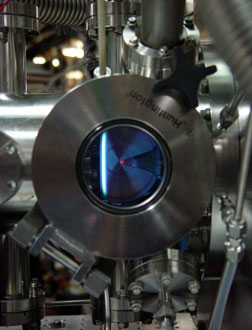Researchers at Sandia National Laboratories’ Combustion Research Facility are part of an international team that has detected a new class of compounds previously unknown in flames, a breakthrough that could lead to soot reduction, decreases in flame pollutants and improved fuel cells.
The discovery of these compounds, called enols, is the biggest breakthrough so far from a powerful new flame chemistry probe, operated at the Advanced Light Source at Lawrence Berkeley National Laboratory (LBNL), that was developed by researchers from Sandia, LBNL, Cornell University, and the University of Massachusetts in late 2002.
This machine, and a similar device operating at the National Synchrotron Radiation Laboratory in

This low-pressure, flame-sampling apparatus shows a rich flame burning in the vacuum chamber. The quartz cone through which flame gases are sampled is visible entering from the right of the apparatus. The tip is glowing because of incandescence of soot deposits on the cone. The burner is on the left; it can be moved horizontally so that gases are sampled from different positions in the flame.
They were found when the team was looking for signatures of different isomers in flames. With this finding, enols can be added to predictive computer models currently used to improve combustion efficiency and cleanliness.
“It is remarkable that, even after 150 years of flame chemistry research, new compounds can be found in flames,” said Craig Taatjes, a combustion chemistry researcher Sandia and lead author of the research paper, published in Science Express, documenting the discovery.
“Enols themselves are chemically interesting; they were predicted to be transient chemical intermediates in 1880, but the first direct observation of the simplest enol, vinyl alcohol, wasn’t until 1973. Although these compounds have been elusive,” he adds, “it turns out they are just sitting in flames.”
The unanticipated detection of enols could also have a significant impact in refining models used to describe fuel cell operation and emission-free waste cleanup using supercritical water oxidation, said Taatjes.
Besides the Sandia scientists, the team that discovered enols in flames includes researchers from




AI-generated medical responses need monitoring, study finds
This would negate most of the benefit of using AI in the first place, rather like the Locomotive Act 1865 that required any self-propelled road...